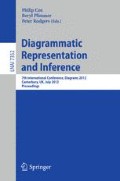Abstract
This paper will examine two ‘ecologies of thought’, which encompass architectural theory, history, pedagogy, and practice.
A lineage of ‘scientific’ diagramming originates from scientific management and the Bauhaus-inspired curriculum introduced to Harvard by Walter Gropius; it incorporates diagrams into a problem-solving methodology, and is exemplified by the ‘bubble diagram’. This scientific emphasis is extended by Christopher Alexander’s urban analysis introducing mathematical set theory. In general, the scientific diagram emphasizes hierarchies and logical relations; it eschews visual resemblance to the subject of its analysis.
The second, post-war, trajectory privileges the semantic and syntactic potential of the diagram, and shifts emphasis from “solving a problem” to “learning a language”; it may be best understood through the ‘Nine Square Grid’ design exercise introduced by John Hejduk, resonating with positions articulated by Colin Rowe, Rudolf Wittkower, and Rudolf Arnheim.
The rendezvous of both trajectories with the digital screen sparks a new typology, diagrammatic controls.
Access this chapter
Tax calculation will be finalised at checkout
Purchases are for personal use only
Preview
Unable to display preview. Download preview PDF.
References
Alexander, C., Chermayeff, S.: Community and Privacy. Toward a new architecture of humanism. Doubleday & Co., Garden City (1963)
Alexander, C.: A City is not a Tree. Architectural Forum 122(1&2) (1965); reprinted in: Thackara, J. (ed.) Design After Modernism: Beyond the Object, pp. 67–84. Thames and Hudson, London (1988)
Alexander, C., Eisenman, P.: Contrasting Concepts of Harmony in Architecture. Lotus International 40, 60–68 (1983)
Arnheim, R.: Art and Visual Perception: A Psychology of the Creative Eye. University of California Press, Berkeley and Los Angeles (1954)
Caragonne, A.: The Texas Rangers: Notes from the Architectural Underground. MIT Press, Cambridge (1991)
Carpo, M.: Architecture in the Age of Printing. MIT Press, Cambridge (2001); for a list and discussion of the Vitruvian diagrams
Collins English Dictionary, A diagram is defined as ‘a sketch, outline, or plan demonstrating the form or workings of something’. HarperCollins Publishers (2003)
Deleuze, G.: Foucault. Athlone, London (1988)
Eisenman, P.: Diagram: An Original Scene of Writing. In: Eisenman, P. (ed.) Diagram Diaries. Thames and Hudson, London (1999)
Frederick, C.: The new housekeeping: efficiency studies in home management. Doubleday, Pape & Co., Garden City (1913)
Frederick, C.: Household engineering. American School of Home Economics, Chicago (1913)
Evans, R.: Figures, Doors, and Passages. In: Evans, R. (ed.) Translations from Drawing to Building and Other Essays, p. 56. Architectural Association, London (1997)
Giedion, S.: Mechanization Takes Command. Oxford University Press, Oxford (1948)
Herdeg, K.: The Decorated Diagram: Harvard Architecture and the Failure of the Bauhaus Legacy. MIT Press, Cambridge (1983)
HSR Hochschule für Technik Rapperswil, CNLAB (2011), http://www.cnlab.ch/fussball/ (accessed August 20, 2011)
Klein, A.: Die Baugilde (November 1927); Reprinted as: Illustrations of German Efficiency Studies. Architectural Record, 299 (March 1929)
Klein, A.: Judging the Small House. Architectural Forum 55, 166–172 (1931)
Krauss, J.: Information at a Glance, On the History of the Diagram, OASE 48, Diagrams (1999)
Krauss, R.E.: Grids, You Say. In: Grids: Format and Image in 20th Century Art. Pace Gallery, New York (1978)
Le Corbusier: Precisions on the present state of architecture and city planning (1930); translated by Edith Schreiber Aujame. MIT Press, Cambridge (1991)
Lueder, C.: Thinking between diagram and image: the ergonomics of abstraction and imitation. Architectural Research Quarterly 15, 57–67 (2011)
Marey, E.-J.: La méthode graphique dans les sciences expérimentales et principalement en physiologie et en medicine, 3rd edn. G. Masson, Paris (1885)
Meyer, H.: My ejection from the Bauhaus. Open letter in the newspaper: Das Tagebuch (August 16, 1930); Reprinted in: Schnaidt, C., Meyer, H.: Bauten, Projekte und Schriften. Buildings, projects and writings, transl. D. Q. Stephenson, p. 103. Architectural Book Publishing Co., New York (1965)
Neufert, E.: Design Method, Architect’s Data. Crosby Lookwood, London (1936); translated by Herz, R., et al. (1970)
Neufert, E.: Bau-Entwurf Arbeitsvorgang, Bauentwurfslehre, 3rd edn. Bauwelt Verlag, Berlin (1936)
Nobbs, P.: Design: A Treatise on the Discovery of Form. Oxford University Press, Oxford (1937)
Pai, H.: The Portfolio and the Diagram. MIT Press, Cambridge (2002)
Pope, A.: Ladders. Princeton Architectural Press, Princeton (1997)
Rowe, C.: The Mathematics of the Ideal Villa. Architectural Review (01), 101–104 (1947)
Rowe, C., Slutzky, R.: Transparency: Literal and Phenomenal. Perspecta 8, 45–54 (1963)
Sawyer, P.: The Planning of Banks. Architectural Forum 38, 263–272 (1923)
Somol, R.E.: Dummy Text, or the Diagrammatic Basis of Contemporary Architecture. In: Eisenman, P. (ed.) Diagram Diaries. Thames and Hudson, London (1999)
Turkle, S.: Life on the Screen. Weidenfeld and Nicholson, London (1996)
Vidler, A.: Diagrams of Diagrams: Architectural Abstraction and Modern Representation. Representations 72 (2000)
Vidler, A.: What is a Diagram Anyway. In: Cassara, S., Eisenman, P., Vidler, A., Kipnis, J. (eds.) Peter Eisenman: Feints. Skira, Milan (2006)
Wittkower, R.: Architectural Principles in the Age of Humanism. Warburg Institute, University of London, London (1949)
Editor information
Editors and Affiliations
Rights and permissions
Copyright information
© 2012 Springer-Verlag Berlin Heidelberg
About this paper
Cite this paper
Lueder, C. (2012). Diagram Ecologies - Diagrams as Science and Game Board. In: Cox, P., Plimmer, B., Rodgers, P. (eds) Diagrammatic Representation and Inference. Diagrams 2012. Lecture Notes in Computer Science(), vol 7352. Springer, Berlin, Heidelberg. https://doi.org/10.1007/978-3-642-31223-6_23
Download citation
DOI: https://doi.org/10.1007/978-3-642-31223-6_23
Publisher Name: Springer, Berlin, Heidelberg
Print ISBN: 978-3-642-31222-9
Online ISBN: 978-3-642-31223-6
eBook Packages: Computer ScienceComputer Science (R0)

